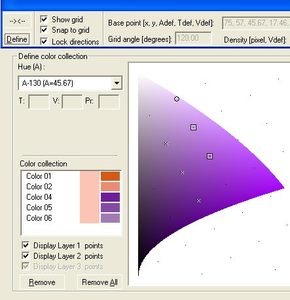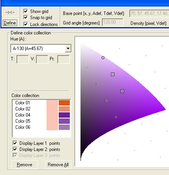Information
- Publication Type: Technical Report
- Workgroup(s)/Project(s):
- Date: June 2005
- Number: TR-186-2-05-05
- Keywords: Color Dynamics, Computational Aesthetics, Coloroid, Color Order System, Color Harmony, Environmental Color Design
Abstract
The paper presents experimentally based rules and methods creating harmonic color sets. Firstly, dichromatic rules will be presented which concern color harmony relationships of only two hues. For an arbitrarily given hue pair, we define the textit{just harmonic} saturation values, resulting in just harmonic color pairs. These values express the fuzzy border between harmony and disharmony regions by a single scalar, most appropriately.Secondly, the value of harmony will be defined corresponding to the textit{contrast of lightness}, i.e. the difference of perceptual lightness values. Thirdly, we formulate the harmony value of the textit{saturation contrast}, depending on hue and lightness. Results of these investigations form a basis for a unified, coherent dichromatic harmony formula as well as for analysis of polychromatic color harmony.
Introduced color harmony rules are based on Coloroid, which is one of the $5-6$ main color-order systems and furthermore it is an textit{aesthetically uniform} continuous color space. Coloroid has simple closed forward and backward transformation formulas with the color space of $CIE~XYZ$. It relies on a huge number of observations and experiments, and it is a very suitable tool of color dynamics for describing aesthetical relationships. It had supported also numerous color plans of great architectural projects having been realized in the practice. The experimental data and information to be retrieved from them are just partly processed and published so far. Our article utilizes a 'slice' of this database, together with additional complementary observations. This paper is an issue of a planned series of articles, dealing with rules and coherences of color harmony based on the Coloroid system.
Additional Files and Images
Weblinks
No further information available.BibTeX
@techreport{TR-186-2-05-05,
title = "Computational Color Harmony based on Coloroid System",
author = "L\'{a}szl\'{o} Neumann and Antal Nemcsics and Attila Neumann",
year = "2005",
abstract = "The paper presents experimentally based rules and methods
creating harmonic color sets. Firstly, dichromatic rules
will be presented which concern color harmony relationships
of only two hues. For an arbitrarily given hue pair, we
define the textit{just harmonic} saturation values,
resulting in just harmonic color pairs. These values express
the fuzzy border between harmony and disharmony regions by a
single scalar, most appropriately. Secondly, the value of
harmony will be defined corresponding to the textit{contrast
of lightness}, i.e. the difference of perceptual lightness
values. Thirdly, we formulate the harmony value of the
textit{saturation contrast}, depending on hue and lightness.
Results of these investigations form a basis for a unified,
coherent dichromatic harmony formula as well as for analysis
of polychromatic color harmony. Introduced color harmony
rules are based on Coloroid, which is one of the $5-6$ main
color-order systems and furthermore it is an
textit{aesthetically uniform} continuous color space.
Coloroid has simple closed forward and backward
transformation formulas with the color space of $CIE~XYZ$.
It relies on a huge number of observations and experiments,
and it is a very suitable tool of color dynamics for
describing aesthetical relationships. It had supported also
numerous color plans of great architectural projects having
been realized in the practice. The experimental data and
information to be retrieved from them are just partly
processed and published so far. Our article utilizes a
'slice' of this database, together with additional
complementary observations. This paper is an issue of a
planned series of articles, dealing with rules and
coherences of color harmony based on the Coloroid system. ",
month = jun,
number = "TR-186-2-05-05",
address = "Favoritenstrasse 9-11/E193-02, A-1040 Vienna, Austria",
institution = "Institute of Computer Graphics and Algorithms, Vienna
University of Technology ",
note = "human contact: technical-report@cg.tuwien.ac.at",
keywords = "Color Dynamics, Computational Aesthetics, Coloroid, Color
Order System, Color Harmony, Environmental Color Design",
URL = "https://www.cg.tuwien.ac.at/research/publications/2005/TR-186-2-05-05/",
}

 Computational Color Harmony
Computational Color Harmony
